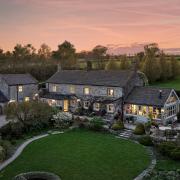Words by Terry Fletcher Photographs by Joan Russell
For generations of squaddies the name Catterick is synonymous with being bawled at from Reveille to Lights Out by fearsome NCOs interspersed with endless hours of square bashing and route marches. Countless raw recruits have been knocked into shape as they got their first taste of army life in Europe’s biggest military base. It’s nothing new. The Romans stationed troops here to protect the crossing of the River Swale on one of their main communication links between the north and south. For horse racing fans the name conjures up a very different picture, year-round racing on one of Yorkshire’s oldest courses.
It would be easy for the tiny village of Catterick (pop 2,500) to be swamped by its huge neighbouring garrison (pop 13,000) but the village and nearby Catterick Bridge have managed to retain their own identity on the eastern fringe of the Yorkshire Dales National Park.
‘People tend to think of the garrison when they hear the name Catterick but there is much more to the village than that,’ says parish clerk Diane Kitchen. ‘Obviously there are very close links between the two, especially now that army families tend not to move around quite so much. Some military families live off the garrison and some choose to settle down here after they leave the army because they like the area so much.
‘Catterick has a very pretty area around Low Green and it is very well placed. We are on the edge of the Dales, just a few miles from Wensleydale and Swaledale and towns like Richmond but being on the A1 as well people can be in Newcastle or York in an hour or so. It sounds like a cliché but it really is the best of both worlds.
‘We also have a strong community spirit with lots going on and a thriving village school with 150 or so children, which is a good size for providing a good education while retaining a family atmosphere,’ she adds. But if many of Catterick’s attractions are unsung outside the area, one is nationally famous -the race course, which stages meetings for 12 months of the year.
General manager Fiona Needham says: ‘Because we have flat and jump racing we can provide a very full programme and draw crowds of between three and four thousand on race days.
‘I think people enjoy coming here because we are very informal and a good introductory track for people who have perhaps not been racing before. Some of the big meetings like York and Doncaster can be a bit intimidating for first timers. Here at Catterick we don’t stand of ceremony too much but we do take our racing very seriously and put on some top quality meetings.
‘We attract a very knowledgeable crowd who really know their horses, genuine racing people. Racing has a very strong tradition here and the first recorded races here were held as far back as 1783.’
Catterick’s biggest surprise, however, lies within the garrison itself. There behind the fences and the security gates is a unique gem, the Foxglove Covert Nature Reserve, which despite its position, is open to the public and attracts up to 20,000 visitors, including school groups, every year.
‘It’s a unique position and an amazing facility,’ says senior reserve manager, Sophie Rainer. ‘One thing’s for sure, being inside Europe’s biggest military base means we don’t get any vandalism. It is certainly a very secure site!’
Visitors do not need to book but they will have to sign in at the garrison gates and bring along some form of identity document, such as a driving licence, before being allowed in. Once inside, the reserve spreads across almost 100 acres of old firing ranges with a wide mix of habitats from moorland edge to natural woodland, heathland and conifers as well as meadows, ponds and streams.
The result, says Sophie, is an astonishing diversity of wildlife, thanks to a mosaic of habitats in a comparatively small area. So far 2,300 different species of animals, plants birds and insects have been recorded and more are being added to the diverse list all the time.
Although officially ranked as only a local nature reserve, thanks to its popularity the reserve also boasts a £350,000 state-of-the-art field centre which would be the envy of many national reserves.
Major Tony Crease, (Retd), says that although the reserve was created by soldiers returning from the first Gulf War it is now very much a community project, despite being within the garrison. ‘I think that is what is behind its success,’ he says. ‘We have service personnel, ex-service people and civilians all working together. It is unique.’
Sophie adds: ‘It started off in quite a small way with a little group of conservation volunteers but it has grown and grown and now I think both the army and the local community can be very proud of what has been achieved.’



























